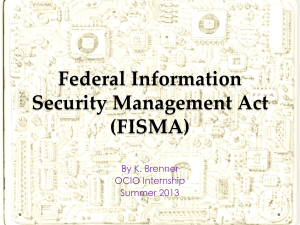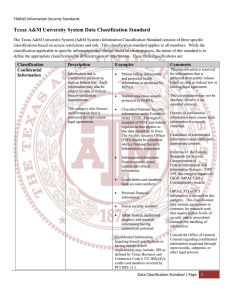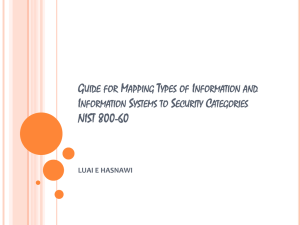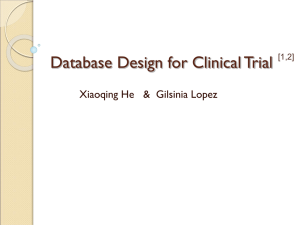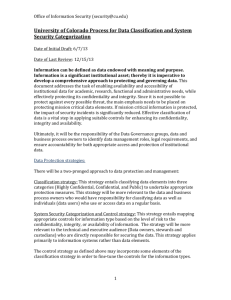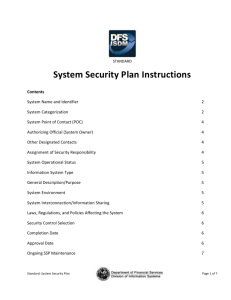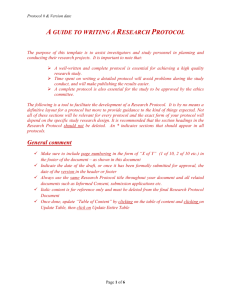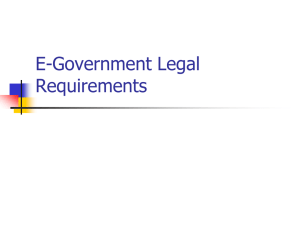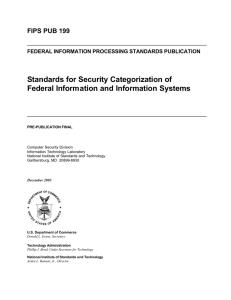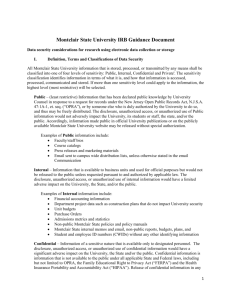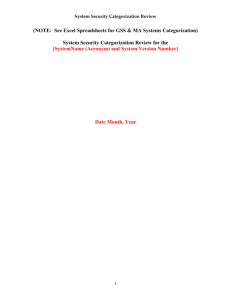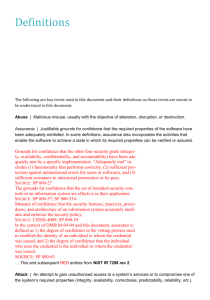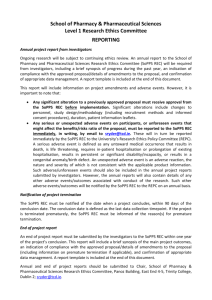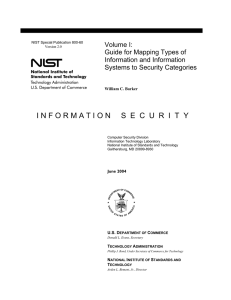Information System Security Plan
advertisement
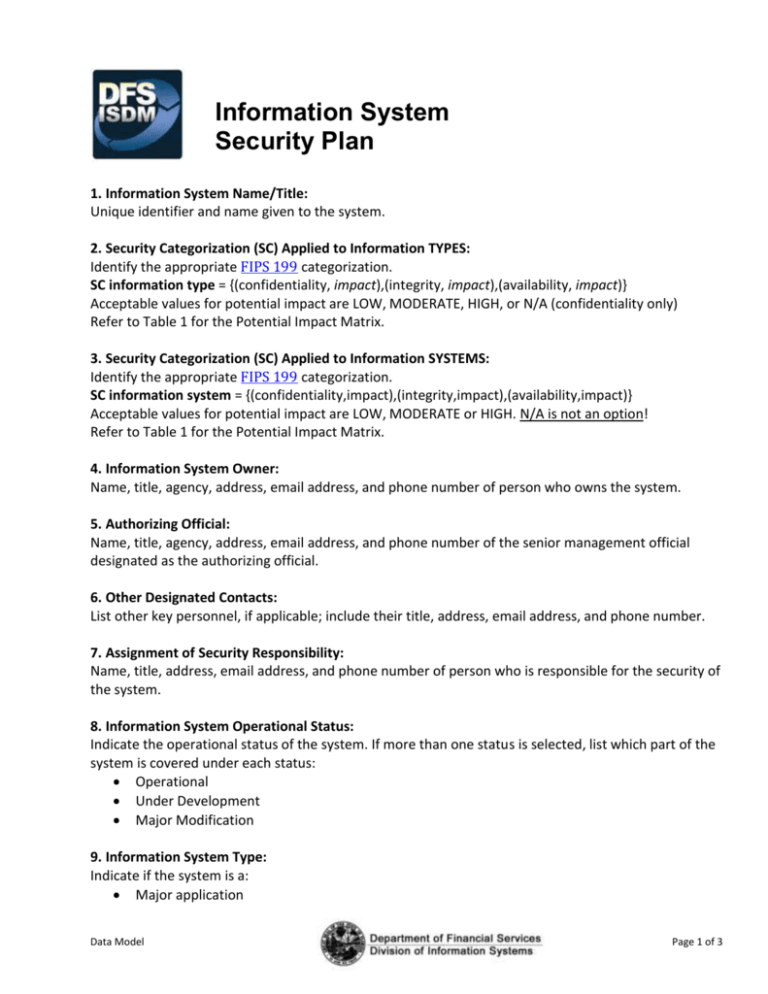
Information System
Security Plan
1. Information System Name/Title:
Unique identifier and name given to the system.
2. Security Categorization (SC) Applied to Information TYPES:
Identify the appropriate FIPS 199 categorization.
SC information type = {(confidentiality, impact),(integrity, impact),(availability, impact)}
Acceptable values for potential impact are LOW, MODERATE, HIGH, or N/A (confidentiality only)
Refer to Table 1 for the Potential Impact Matrix.
3. Security Categorization (SC) Applied to Information SYSTEMS:
Identify the appropriate FIPS 199 categorization.
SC information system = {(confidentiality,impact),(integrity,impact),(availability,impact)}
Acceptable values for potential impact are LOW, MODERATE or HIGH. N/A is not an option!
Refer to Table 1 for the Potential Impact Matrix.
4. Information System Owner:
Name, title, agency, address, email address, and phone number of person who owns the system.
5. Authorizing Official:
Name, title, agency, address, email address, and phone number of the senior management official
designated as the authorizing official.
6. Other Designated Contacts:
List other key personnel, if applicable; include their title, address, email address, and phone number.
7. Assignment of Security Responsibility:
Name, title, address, email address, and phone number of person who is responsible for the security of
the system.
8. Information System Operational Status:
Indicate the operational status of the system. If more than one status is selected, list which part of the
system is covered under each status:
Operational
Under Development
Major Modification
9. Information System Type:
Indicate if the system is a:
Major application
Data Model
Page 1 of 3
General support system
If the system contains minor applications, list them in Section 10 - General System
Description/Purpose.
10. General System Description/Purpose
Describe the function or purpose of the system and the information processes.
11. System Environment
Provide a general description of the technical system. Include the primary hardware, software, and
communications equipment.
12. System Interconnections/Information Sharing
List interconnected systems and system identifiers (if appropriate):
1. System name
2. Organization
3. System type (major application or general support system)
4. Indicate if there is an SLA/MOU or other agreement on file
5. Date of agreement to interconnect
6. FIPS 199 category
7. The name of the authorizing official
13. Related Laws/Regulations/Policies
List any laws or regulations that establish specific requirements for the confidentiality, integrity, or
availability of the data in the system.
14. Minimum Security Controls
Select the appropriate minimum security control baseline (low-, moderate-, high-impact) from NIST SP
800-53, then provide a thorough description of how all the minimum security controls in the
applicable baseline are being implemented or planned to be implemented. The description should
contain:
1. The security control title
2. How the security control is being implemented or planned to be implemented
3. Any scoping guidance that has been applied and what type of consideration
4. Indicate if the security control is a common control and who is responsible for its
implementation
15. Information System Security Plan Completion Date: _____________________
Enter the completion date of the plan.
16. Information System Security Plan Approval Date: _______________________
Enter the date the system security plan was approved and indicate if the approval documentation is
attached or on file.
Data Model
Page 2 of 3
POTENTIAL IMPACT
Security Objective
LOW
MODERATE
HIGH
Confidentiality
Preserving authorized
restrictions on
information access and
disclosure, including
means for protecting
personal privacy and
proprietary information.
[44 U.S.C., SEC. 3542]
The unauthorized
disclosure of
information could be
expected to have a
limited adverse effect
on organizational
operations,
organizational assets,
or individuals.
The unauthorized
disclosure of
information could be
expected to have a
serious adverse effect
on organizational
operations,
organizational assets,
or individuals.
Integrity
Guarding against
improper information
modification or
destruction, and includes
ensuring information
non-repudiation and
authenticity.
[44 U.S.C., SEC. 3542]
The unauthorized
modification or
destruction of
information could be
expected to have a
limited adverse effect
on organizational
operations,
organizational assets,
or individuals.
The unauthorized
modification or
destruction of
information could be
expected to have a
serious adverse effect
on organizational
operations,
organizational assets,
or individuals.
Availability
Ensuring timely and
reliable access to and use
of information.
[44 U.S.C., SEC. 3542]
The disruption of
access to or use of
information or an
information system
could be expected to
have a limited
adverse effect on
organizational
operations,
organizational assets,
or individuals.
The disruption of
access to or use of
information or an
information system
could be expected to
have a serious
adverse effect on
organizational
operations,
organizational assets,
or individuals.
The unauthorized
disclosure of
information could be
expected to have a
severe or catastrophic
adverse effect on
organizational
operations,
organizational assets, or
individuals.
The unauthorized
modification or
destruction of
information could be
expected to have a
severe or catastrophic
adverse effect on
organizational
operations,
organizational assets, or
individuals.
The disruption of access
to or use of information
or an information
system could be
expected to have a
severe or catastrophic
adverse effect on
organizational
operations,
organizational assets, or
individuals.
Table 1: Potential Impact Definitions for Security Objectives
Data Model
Page 3 of 3
